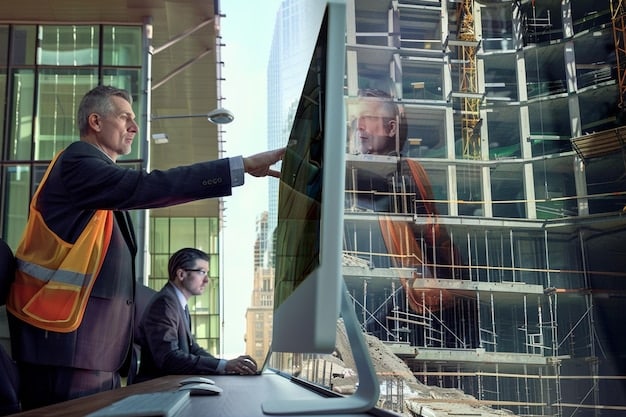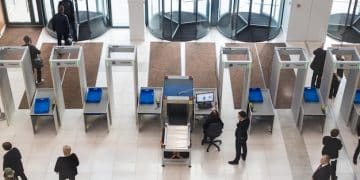US Airport Modernization: $5 Billion Investment by 2025 Announced

The US government plans to invest $5 billion by 2025 in airport modernization projects, promising significant improvements in infrastructure, passenger experience, and operational efficiency across the nation’s airports.
Get ready for smoother travels! The US Government to Invest $5 Billion in Airport Modernization Projects by 2025: Expect Improvements nationwide, enhancing your flying experience from check-in to takeoff.
Investing in America’s Airports: A New Era of Travel
America’s airports are poised for a significant upgrade. The US government’s commitment to invest $5 billion by 2025 signals a new era for air travel within the country. This injection of funds will not only modernize aging infrastructure but also enhance passenger experiences and improve overall operational efficiency.
This initiative aims to address critical infrastructure needs, reduce congestion, and incorporate innovative technologies to meet the growing demands of air travel. Let’s delve into the specifics of this ambitious plan and explore what it means for travelers and the aviation industry.
Addressing Critical Infrastructure Needs
Many US airports are grappling with aging infrastructure that struggles to keep pace with increasing passenger volumes. This investment will address these challenges by funding projects focused on repairing and upgrading essential facilities, such as runways, taxiways, and terminals.
These improvements will not only enhance safety and efficiency but also extend the lifespan of these critical assets, ensuring the long-term viability of the nation’s air transportation system.
Enhancing Passenger Experience
Beyond physical infrastructure, the modernization projects will also prioritize enhancing the overall passenger experience. This includes improvements to check-in processes, security screening, and baggage handling, all designed to reduce wait times and streamline the travel journey.
- Faster check-in kiosks and automated baggage systems.
- Improved signage and wayfinding to navigate airports easily.
- Comfortable waiting areas with more seating and charging stations.
Boosting Operational Efficiency
Modernizing airport infrastructure will also lead to significant improvements in operational efficiency. By incorporating advanced technologies and optimizing processes, airports can reduce delays, minimize congestion, and improve the overall flow of air traffic.
These improvements will not only benefit airlines and airport operators but also contribute to a more seamless and predictable travel experience for passengers.
In conclusion, the US government’s investment in airport modernization is a crucial step toward creating a more efficient, safe, and enjoyable air travel experience for everyone. By addressing critical infrastructure needs, enhancing passenger experiences, and boosting operational efficiency, this initiative will pave the way for a new era of travel in the United States.

Focus on Sustainability: Green Airports of the Future
Sustainability is a key focus of the airport modernization projects. The US government is committed to promoting environmentally friendly practices within the aviation industry, and these investments will support the development of “green” airports across the country.
From energy-efficient buildings to renewable energy sources, airports are embracing innovative solutions to reduce their environmental footprint and create a more sustainable future for air travel.
Energy-Efficient Buildings and Infrastructure
Modern airport designs are incorporating energy-efficient features to reduce energy consumption and minimize environmental impact. These include the use of sustainable building materials, improved insulation, and energy-efficient lighting and HVAC systems.
By reducing their reliance on traditional energy sources, airports can significantly lower their carbon footprint and contribute to a cleaner environment.
Renewable Energy Sources
Many airports are exploring the use of renewable energy sources, such as solar and wind power, to generate electricity and reduce their dependence on fossil fuels. Solar panels are being installed on rooftops and parking structures, while wind turbines are being erected in strategic locations around the airport.
These renewable energy projects not only reduce greenhouse gas emissions but also provide a reliable and cost-effective source of power for airport operations.
Water Conservation and Waste Management
Airports are also implementing water conservation measures and improving waste management practices to minimize their environmental impact. This includes the use of low-flow fixtures, rainwater harvesting systems, and efficient irrigation techniques.
- Implementing comprehensive recycling programs.
- Reducing single-use plastics and promoting reusable alternatives.
- Composting food waste and organic materials.
By reducing their water consumption and minimizing waste generation, airports can contribute to a more sustainable and resource-efficient future.
In summary, the focus on sustainability within the airport modernization projects reflects a growing commitment to environmental responsibility within the aviation industry. By embracing green technologies and sustainable practices, airports are working to reduce their environmental footprint and create a more sustainable future for air travel.
Technological Advancements: AI and Automation in Airports
Technological advancements are playing a crucial role in modernizing airports and transforming the passenger experience. From artificial intelligence (AI) to automation, airports are embracing innovative technologies to improve efficiency, enhance security, and streamline operations.
These advancements are not only making air travel more convenient and enjoyable but also contributing to a safer and more secure environment for passengers and employees.
Artificial Intelligence (AI) Applications
AI is being used in a variety of applications to improve airport operations and enhance the passenger experience. AI-powered systems are being deployed to optimize traffic flow, predict potential disruptions, and personalize passenger services.
These include AI-powered chatbots that provide real-time information and assistance to passengers, as well as AI-driven security systems that can detect potential threats more effectively.
Automation of Baggage Handling and Security
Automation is streamlining baggage handling and security processes, reducing wait times and improving efficiency. Automated baggage systems use advanced tracking technologies to ensure that luggage is routed quickly and accurately to its destination.
- Automated security screening lanes that use AI to identify potential threats more efficiently.
- Robotic systems that assist with baggage handling and sorting.
- Self-boarding gates that allow passengers to board flights quickly and easily.
Biometric Identification and Facial Recognition
Biometric identification and facial recognition technologies are being implemented to enhance security and streamline passenger processing. These technologies allow airports to verify passenger identities quickly and accurately, reducing the need for manual checks and improving security.
Facial recognition systems are also being used to personalize passenger services, such as providing targeted information and recommendations based on individual preferences.
In conclusion, technological advancements are revolutionizing the way airports operate and enhancing the overall travel experience. By embracing AI, automation, and biometric technologies, airports are becoming more efficient, secure, and passenger-friendly.
Economic Impact: Job Creation and Regional Development
The airport modernization projects are expected to have a significant economic impact, creating jobs and stimulating regional development. The construction and renovation activities will generate employment opportunities in a variety of sectors, including construction, engineering, and manufacturing.
Furthermore, the improved airport infrastructure will attract more businesses and investment to the surrounding areas, boosting economic growth and creating long-term opportunities.
Job Creation in Construction and Related Industries
The airport modernization projects will require a significant workforce, creating numerous job opportunities in construction and related industries. These include skilled tradespeople, such as carpenters, electricians, and plumbers, as well as engineers, architects, and project managers.
The increased demand for labor will boost local economies and provide employment opportunities for residents in the surrounding communities.
Attracting Businesses and Investment
Improved airport infrastructure will make the region more attractive to businesses and investors. Modernized airports can handle more flights and passengers, making it easier for companies to transport goods and personnel.
This can lead to increased economic activity, job growth, and higher property values in the surrounding areas.
Boosting Tourism and Trade
Modernized airports can also boost tourism and trade by making it easier for visitors and businesses to access the region. This can lead to increased revenue for local businesses, as well as more investment in tourism-related infrastructure.
Additionally, improved air connectivity can facilitate international trade, connecting local businesses to global markets and driving economic growth.
In summary, the airport modernization projects will have a significant economic impact, creating jobs, attracting businesses and investment, and boosting tourism and trade. This initiative will not only improve air travel but also contribute to the overall economic prosperity of the region.

Passenger Experience Improvements: Comfort and Convenience
A crucial aspect of the airport modernization projects is improving the passenger experience. This includes enhancing comfort, convenience, and accessibility for all travelers. Renovations and upgrades aim to create a more enjoyable and stress-free travel experience.
These improvements can significantly impact passenger satisfaction, leading to greater loyalty and positive word-of-mouth referrals.
Enhanced Amenities and Services
Airports are focusing on providing enhanced amenities and services to meet the diverse needs of travelers. This includes comfortable seating areas, charging stations, free Wi-Fi, and a variety of dining and retail options.
These amenities can help passengers relax, stay connected, and make the most of their time at the airport.
Improved Accessibility for Passengers with Disabilities
Ensuring accessibility for passengers with disabilities is a top priority. Airports are implementing a range of measures to improve accessibility, including ramps, elevators, accessible restrooms, and assistive listening devices.
These improvements ensure that all travelers can navigate the airport comfortably and independently.
Reducing Wait Times and Streamlining Processes
Reducing wait times and streamlining processes is another key focus. Airports are implementing technologies and strategies to speed up check-in, security screening, and baggage handling.
This includes the use of self-service kiosks, automated security lanes, and efficient baggage systems, all designed to minimize delays and improve the flow of passengers.
In conclusion, improving the passenger experience is a critical component of the airport modernization projects. By enhancing amenities, improving accessibility, and reducing wait times, airports are striving to create a more comfortable, convenient, and enjoyable travel experience for all passengers.
Challenges and Opportunities: Navigating the Future of Air Travel
While the airport modernization projects offer numerous benefits, they also present challenges. Effectively managing construction projects, minimizing disruptions to air travel, and securing funding are crucial to the success of these initiatives.
Addressing these challenges and embracing emerging opportunities will be key to navigating the future of air travel.
Managing Construction and Minimizing Disruptions
Managing construction projects and minimizing disruptions to air travel is a significant challenge. Construction activities can cause delays, congestion, and noise pollution, impacting both passengers and airport operations.
- Implementing phased construction plans to minimize disruptions.
- Communicating effectively with passengers about potential delays.
- Using advanced construction techniques to reduce noise and dust.
Securing Funding and Ensuring Accountability
Securing funding and ensuring accountability are critical to the success of the airport modernization projects. The $5 billion investment is a significant step, but additional funding may be needed to complete all planned projects.
Transparent and accountable financial management is essential to ensure that funds are used effectively and efficiently.
Embracing Emerging Technologies and Trends
Embracing emerging technologies and trends is essential to staying ahead in the evolving aviation industry. This includes the use of drones for airport inspections, the development of electric aircraft, and the adoption of new cybersecurity measures.
By embracing these technologies and trends, airports can enhance safety, improve efficiency, and create a more sustainable future for air travel.
In summary, navigating the future of air travel requires addressing challenges, securing funding, and embracing emerging technologies. By proactively managing these issues, airports can ensure that the modernization projects are successful and that the aviation industry continues to thrive.
| Key Point | Brief Description |
|---|---|
| ✈️ Infrastructure Upgrade | Runways, terminals, and taxiways will be modernized. |
| 💼 Economic Boost | Job creation and regional economic development are expected. |
| 🛡️ Passenger Experience | Amenities, accessibility, and streamlined processes will improve travel. |
| 🌍 Sustainability Focus | Energy-efficient buildings and renewable energy sources are being implemented. |
FAQ
▼
The primary goal is to improve the infrastructure, passenger experience, and operational efficiency of US airports by investing in upgrades and new technologies.
▼
The US government is investing $5 billion in airport modernization projects by 2025, as part of a broader effort to enhance the nation’s air travel infrastructure.
▼
Passengers can expect faster check-in processes, improved security screening, enhanced amenities, and reduced wait times, leading to a more comfortable travel experience.
▼
Yes, the airport modernization projects are expected to create numerous job opportunities in construction, engineering, and related industries, boosting local economies.
▼
Sustainability will be a key focus, with airports implementing energy-efficient buildings, renewable energy sources, and improved water conservation and waste management practices.
Conclusion
The US government’s $5 billion investment in airport modernization projects signals a significant commitment to improving air travel infrastructure and enhancing the passenger experience. With advancements in technology, a focus on sustainability, and a drive for economic growth, these projects promise a brighter future for US airports and the millions of travelers who pass through them each year.





